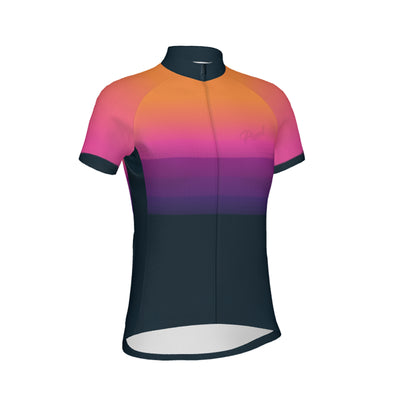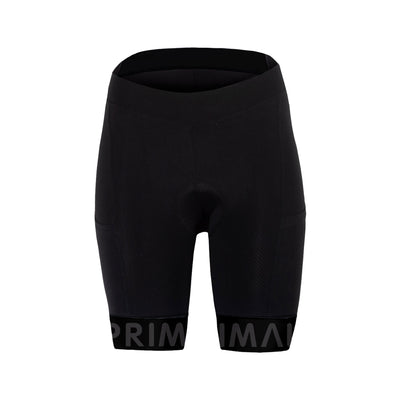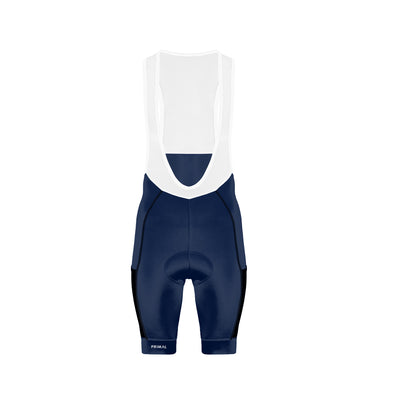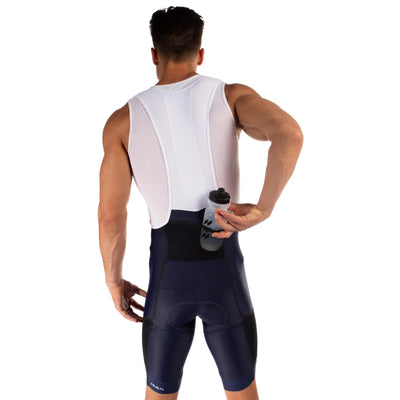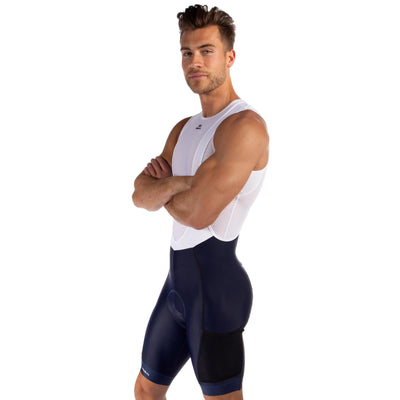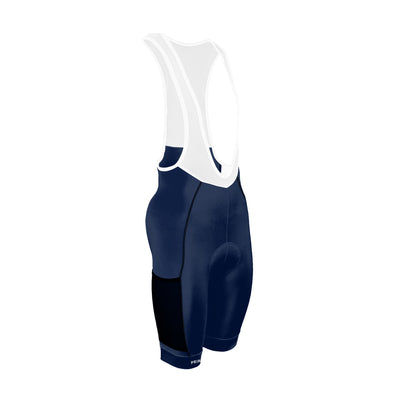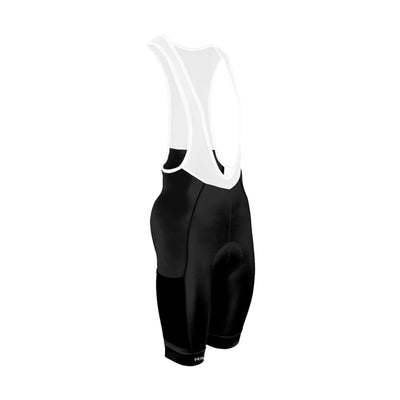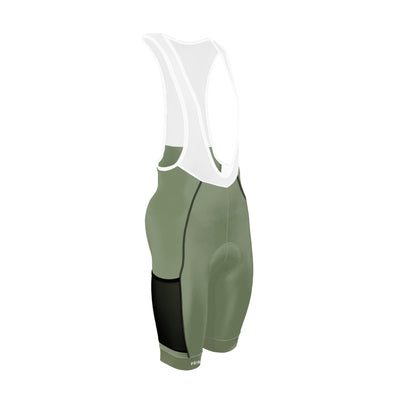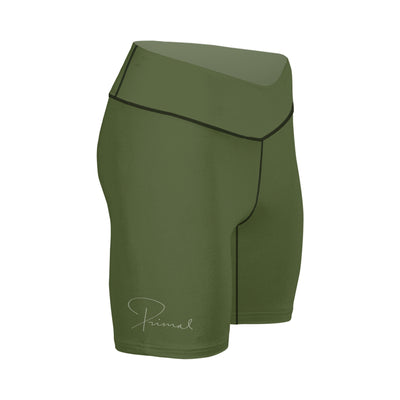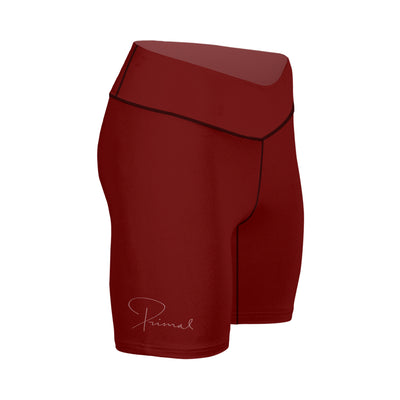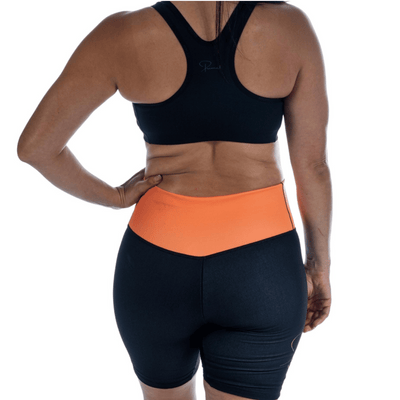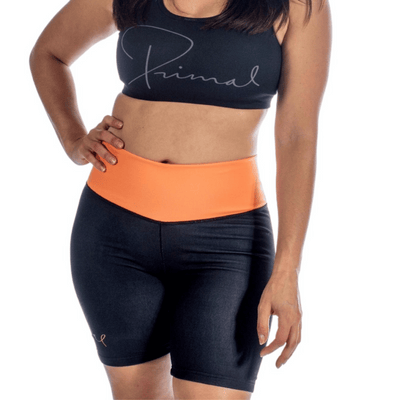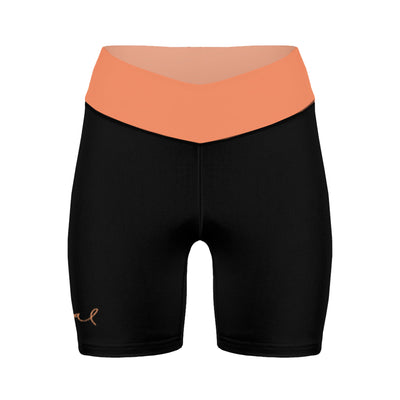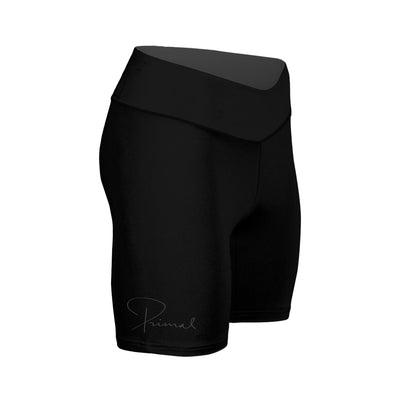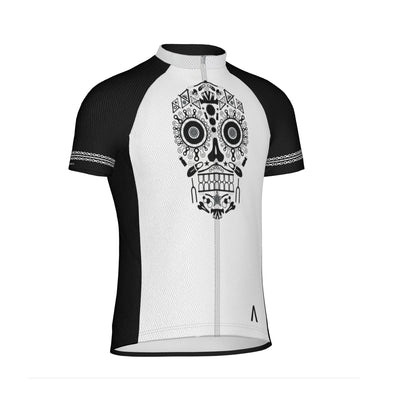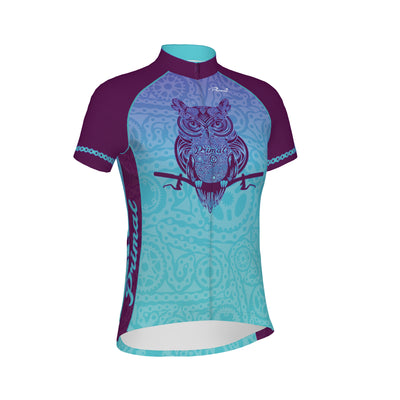The Guide to Bike Shorts for Beginners
Types of Bike Shorts
Padded vs. Non-Padded Shorts
Benefits of Padded Shorts
Comfort
The primary purpose of the chamois is to provide cushioning and reduce pressure on sensitive areas, which can significantly increase comfort during long rides.
Shock Absorption
Padded shorts absorb road vibrations and shocks, reducing the impact on the body and minimising fatigue.
Chafing Prevention
The smooth surface of the chamois reduces friction between the body and the saddle, helping to prevent chafing and saddle sores.
Moisture Management
Many padded shorts feature moisture-wicking properties to keep the skin dry and prevent saddle area discomfort caused by sweat buildup.

Benefits of Non-Padded Shorts
Streamlined Fit
Non-padded shorts offer a sleek, form-fitting silhouette without the bulkiness of a chamois, making them ideal for cyclists who prefer a more minimalist feel.
Versatility
Non-padded shorts can be worn as standalone garments for shorter rides or as a base layer under loose-fitting shorts or pants for added comfort and support.
Quick-Drying
Without a chamois, non-padded shorts tend to dry more quickly after washing, making them a convenient option for frequent use.
Multi-Sport Use
Non-padded shorts are versatile enough to be used for various athletic activities beyond cycling, such as running, hiking, or gym workouts.

Featured Shorts
Choosing Between Padded and Non-Padded Shorts
Bib Shorts vs. Waist Shorts
Features of Bib Shorts
Bib Straps
The key feature of bib shorts is the suspenders, which distribute pressure evenly across the upper body and prevent the shorts from slipping down during rides. The straps are usually made from stretchy, breathable fabric and may have adjustable closures for a customisable fit.
Enhanced Comfort
By eliminating the need for a constricting waistband, bib shorts offer a more comfortable and unrestricted fit around the waist and abdomen. This design also reduces the risk of chafing and irritation caused by elastic waistbands digging into the skin.
Stay-Put Fit
The bib straps hold the shorts securely in place, even during intense rides or aggressive movements. This ensures that the chamois stays properly positioned and provides optimal cushioning and support where needed.
Aerodynamic Profile
Bib shorts often feature a sleek, aerodynamic design with minimal seams and panels, reducing drag and enhancing speed for road cyclists and competitive riders.

Waist Shorts
Features of Waist Shorts
Elastic Waistband
Waist shorts feature a stretchy elastic waistband that conforms to the shape of the wearer's waist, providing a snug and secure fit. The waistband may have a drawstring or adjustable closure for added customisation.
Easy On-and-Off
The absence of bib straps makes waist shorts easier to put on and take off compared to bib shorts, which require threading the suspenders over the shoulders
Versatility
Waist shorts are versatile and can be worn by cyclists of all levels and riding styles, from casual commuters to competitive racers. They are also compatible with a wide range of cycling jerseys and tops.
Cost-Effectiveness
Waist shorts are typically more affordable than bib shorts, making them a budget-friendly option for cyclists looking for high-quality performance without breaking the bank.

Choosing Between Bib Shorts and Waist Shorts
Baggy Shorts for Mountain Biking
Features of Baggy Shorts for Mountain Biking
Loose Fit
Baggy shorts are characterized by their relaxed fit, which provides ample room for freedom of movement and airflow. The loose fit allows for comfortable pedaling and maneuvering on technical terrain without feeling restricted.
Durable Outer Shell
Baggy shorts are constructed with a durable outer shell made from materials like nylon or polyester. This outer layer offers abrasion resistance and protection against branches, rocks, and other trail obstacles encountered during mountain biking.
Pockets
Many baggy shorts come equipped with multiple pockets, including zippered or Velcro-secured cargo pockets on the thighs and/or rear pockets. These pockets provide convenient storage for essentials like snacks, tools, keys, or a mobile phone while riding.
Adjustable Waistband
Baggy shorts often feature an adjustable waistband with Velcro tabs or a buckle closure for a customizable fit. This allows riders to tighten or loosen the waistband to achieve the perfect fit and prevent the shorts from sliding down during aggressive descents.
Inner Liner or Removable Padding
Some baggy shorts come with a removable inner liner or padded insert, similar to traditional cycling shorts. This liner provides additional cushioning and support for long rides or rough terrain, while also wicking away moisture to keep the rider dry and comfortable.
Ventilation
To prevent overheating and maintain breathability, many baggy shorts feature strategically placed mesh panels or ventilation vents. These vents allow air to circulate freely, helping to regulate body temperature and prevent sweat buildup.

Benefits of Baggy Shorts for Mountain Biking
Comfort
The loose, relaxed fit of baggy shorts offers superior comfort and freedom of movement, making them ideal for extended periods of mountain biking.
Protection
The durable outer shell of baggy shorts provides protection against abrasions, scratches, and impacts from trail debris, enhancing rider safety on challenging terrain.
Storage
The addition of pockets allows riders to carry essential items without the need for a separate backpack or hydration pack, providing convenience and accessibility on the trail.
Versatility
Baggy shorts can be worn for various outdoor activities beyond mountain biking, such as hiking, trail running, or casual wear, making them a versatile addition to any outdoor enthusiast's wardrobe.

Mountain Biking
Key Features for biking shorts
Fabric and Construction
Fabric
The fabric used in bike shorts plays a significant role in determining their comfort, breathability, moisture-wicking properties, and overall performance. Common fabrics used in bike shorts include:
1. Lycra or Spandex Blends: Lycra or spandex blends are popular choices for bike shorts due to their stretchiness and ability to conform to the body's contours. These fabrics offer excellent flexibility and freedom of movement, allowing for a comfortable and snug fit without restricting mobility.
2. Nylon or Polyester: Nylon and polyester fabrics are often used in the outer shell of baggy shorts for mountain biking. These materials are durable, abrasion-resistant, and quick-drying, making them well-suited for rugged outdoor environments.
3. Mesh Panels: Many bike shorts feature strategically placed mesh panels or ventilation zones to enhance breathability and airflow. Mesh panels allow heat and moisture to escape, keeping the rider cool and dry during intense rides or warm weather conditions.
Construction
The construction of bike shorts refers to how they are assembled and stitched together. High-quality construction techniques contribute to the shorts' durability, comfort, and performance. Key aspects of construction include:
1. Flatlock Seams: Flatlock seams are used in bike shorts to minimize chafing, rubbing, and irritation during rides. Unlike traditional seams, which can cause discomfort and pressure points, flatlock seams lay flat against the skin, reducing friction and preventing hot spots.
2. Reinforced Stitching: Bike shorts often feature reinforced stitching in high-stress areas, such as the seat, thighs, and waistband, to enhance durability and longevity. Double or triple stitching techniques are used to reinforce seams and prevent them from unraveling over time.
3. Elastic Waistbands or Leg Grippers: Elastic waistbands or silicone leg grippers are common features in bike shorts to ensure a secure and comfortable fit. Waistbands with elastic or drawstring closures help keep the shorts in place during rides, while silicone leg grippers prevent them from riding up or bunching.
4. Padding Placement: In padded bike shorts, the placement and construction of the chamois (padding) are critical for providing cushioning and support where needed. The chamois should be ergonomically shaped to conform to the body's anatomy and strategically positioned to protect the sit bones, perineum, and groin area.
Overall, the fabric and construction of bike shorts play a significant role in determining their comfort, performance, and durability. By choosing shorts made from high-quality materials with thoughtful construction techniques, cyclists can enjoy a more comfortable and enjoyable riding experience, whether on road or trail.

Padding Thickness and Material
Padding Thickness
The thickness of the padding, also known as the chamois, varies among different bike shorts and is measured in millimeters. Padding thickness can range from thin, low-profile inserts to thicker, more substantial cushions. The ideal thickness depends on personal preference, riding style, and the duration of rides.
1. Thin Padding: Thin padding is suitable for cyclists who prefer a minimalist feel and maximum freedom of movement. These shorts are often favored by competitive riders or those participating in short-distance rides. Thin padding provides minimal cushioning and support, making them ideal for cyclists with well-conditioned sit bones and a more aggressive riding position.
2. Medium Thickness Padding: Medium thickness padding strikes a balance between comfort and performance, offering adequate cushioning for most riders. These shorts are suitable for recreational cyclists or those embarking on moderate to long-distance rides. Medium padding provides sufficient shock absorption and pressure relief without feeling overly bulky or restrictive.
3. Thick Padding: Thick padding is designed for cyclists seeking maximum comfort and support, particularly during long rides or on rough terrain. These shorts are ideal for touring cyclists, endurance riders, or individuals prone to saddle soreness. Thick padding provides ample cushioning and protection, reducing pressure on sensitive areas and minimizing discomfort.
Padding Material
The material used in bike shorts padding is essential for moisture management, breathability, and antibacterial properties. Common padding materials include:
1. Foam: Foam padding is the most common material used in bike shorts chamois. It comes in various densities and thicknesses to provide customized levels of cushioning and support. High-density foam offers superior shock absorption, while low-density foam provides a softer, more plush feel.
2. Airmesh: Airmesh, as a padding material, offers a blend of comfort and breathability crucial for long rides. Its open-cell structure facilitates airflow, keeping the rider cool and dry, even during intense cycling sessions. The lightweight nature of Airmesh ensures minimal bulkiness, enhancing freedom of movement without compromising on cushioning. Its moisture-wicking properties further contribute to a comfortable riding experience by preventing sweat buildup, reducing the risk of chafing and discomfort.
3. Gel: Gel padding is often used in conjunction with foam to enhance comfort and reduce pressure points.
4. Multi-Density Padding: Some bike shorts feature multi-density padding, which combines different foam densities to target specific pressure points and provide optimal support. Multi-density padding offers superior shock absorption and comfort, particularly during long rides or intense cycling activities.
5. Antibacterial Treatment: Many bike shorts padding materials are treated with antibacterial agents to prevent odor-causing bacteria growth and maintain hygiene. Antibacterial treatments help keep the chamois fresh and odor-free, even after multiple rides.
Cyclists should consider their riding preferences, duration of rides, and specific comfort needs when selecting bike shorts with the ideal padding characteristics.

Ventilation and Moisture Management
Ventilation
Ventilation refers to the ability of bike shorts to allow air to circulate freely around the body, helping to regulate temperature and prevent overheating. Proper ventilation is essential for keeping cyclists cool, dry, and comfortable, particularly during intense rides or in warm weather conditions. Key factors that contribute to ventilation in bike shorts include:
1. Mesh Panels: Many bike shorts feature strategically placed mesh panels or ventilation zones in areas prone to heat buildup, such as the groin, thighs, and lower back. Mesh panels allow air to flow freely, promoting airflow and cooling the body's core temperature.
2. Perforations: Some bike shorts incorporate perforated fabric or laser-cut vents to enhance ventilation and breathability. Perforations create tiny openings in the fabric, allowing heat and moisture to escape while maintaining the integrity and structure of the shorts.
3. Breathable Fabrics: Bike shorts made from breathable fabrics, such as moisture-wicking polyester or lightweight mesh, help draw moisture away from the skin and allow it to evaporate quickly. Breathable fabrics enhance airflow and prevent sweat buildup, keeping cyclists cool and comfortable throughout their rides.
4. Strategic Design: The design and construction of bike shorts play a crucial role in promoting ventilation. Shorts with a streamlined, aerodynamic profile and minimal seams reduce airflow resistance and enhance breathability. Additionally, features like stretch panels or articulated seams allow for unrestricted movement and airflow during pedaling.
Moisture Management
Moisture management refers to the ability of bike shorts to wick away sweat and moisture from the skin, keeping cyclists dry and comfortable during rides. Effective moisture management is essential for preventing chafing, irritation, and saddle sores caused by prolonged exposure to damp conditions. Key factors that contribute to moisture management in bike shorts include:
1. Moisture-Wicking Fabrics: Bike shorts made from moisture-wicking fabrics, such as polyester or nylon blends, are designed to pull moisture away from the skin and transport it to the outer surface of the fabric for evaporation. Moisture-wicking fabrics help keep cyclists dry and comfortable by preventing sweat from accumulating on the skin.
2. Quick-Drying Properties: Bike shorts with quick-drying properties allow moisture to evaporate rapidly, reducing the risk of dampness and discomfort during rides. Quick-drying fabrics help maintain a consistent body temperature and prevent overheating, even during intense exertion.
3. Antibacterial Treatment: Some bike shorts are treated with antibacterial agents to inhibit the growth of odor-causing bacteria and fungi. Antibacterial treatments help prevent the buildup of odor and maintain freshness, even after multiple rides.
4. Seamless Construction: Bike shorts with seamless or flatlock seam construction minimize friction and rubbing against the skin, reducing the risk of chafing and irritation. Seamless designs prevent moisture from accumulating in seams, keeping cyclists dry and comfortable throughout their rides.
By choosing shorts with breathable fabrics, strategic ventilation, and advanced moisture-wicking properties, cyclists can stay cool, dry, and comfortable on every ride.

Shorts & Bibs
Benefits for Beginners
Enhanced Comfort
Padding
Bike shorts are equipped with a padded insert, known as a chamois, strategically placed in the seat area. This padding provides cushioning and support to the sit bones, perineum, and groin, reducing pressure and discomfort during long rides. The padding helps absorb shock from road vibrations and impacts, enhancing overall comfort and reducing fatigue.
Moisture-Wicking Fabrics
Bike shorts are typically made from moisture-wicking fabrics, such as polyester or nylon blends, designed to draw sweat away from the skin and facilitate evaporation. This moisture-wicking capability helps keep cyclists dry and comfortable by preventing sweat buildup and reducing the risk of chafing and irritation.
Seamless Construction
Many bike shorts feature seamless or flatlock seam construction to minimize friction and rubbing against the skin. Seamless designs prevent chafing and irritation, ensuring a smooth and comfortable riding experience, even during prolonged rides.
Breathable Design
Bike shorts often incorporate ventilation features such as mesh panels, perforations, or breathable fabrics to enhance airflow and regulate body temperature. Improved breathability helps prevent overheating and keeps cyclists cool and comfortable, particularly in warm weather conditions.

Enhanced Support
Compression Fit
Bike shorts are designed to fit snugly against the body, providing compression and support to the muscles during rides. Compression garments help improve blood circulation, reduce muscle fatigue, and enhance overall performance by minimizing muscle vibration and stabilizing the body's core.
Elastic Waistbands or Bib Straps
Bike shorts feature elastic waistbands or bib straps to ensure a secure and comfortable fit. Elastic waistbands with drawstring closures or bib straps with adjustable suspenders help keep the shorts in place during rides, preventing them from slipping down or shifting out of position.
Anatomical Design
Bike shorts are anatomically shaped to conform to the body's contours and provide optimal support and coverage. The shorts are designed to fit snugly without restricting movement, ensuring maximum comfort and support throughout the entire ride.
Reinforced Padding
The padding in bike shorts is often reinforced in key areas to provide targeted support and cushioning where needed most. Reinforced padding helps distribute pressure evenly, reduce saddle soreness, and enhance overall comfort, particularly during long rides or on rough terrain.
Overall, the combination of enhanced comfort and support in bike shorts is essential for optimizing a cyclist's riding experience. By providing cushioning, moisture-wicking capabilities, compression, and anatomical support, bike shorts help cyclists stay comfortable, confident, and focused on the road or trail ahead.

Reduced Chafing and Irritation
Overall, the combination of enhanced comfort and support in bike shorts is essential for optimizing a cyclist's riding experience. By providing cushioning, moisture-wicking capabilities, compression, and anatomical support, bike shorts help cyclists stay comfortable, confident, and focused on the road or trail ahead.
Flatlock Seams
Bike shorts often feature flatlock seams, which are stitched in a way that creates a flat, smooth surface against the skin. Unlike traditional seams that protrude and may cause rubbing or irritation, flatlock seams minimize friction and rubbing, reducing the risk of chafing. This seamless construction ensures that there are no rough edges or raised seams to irritate the skin, providing a more comfortable riding experience.
Smooth Fabrics
Bike shorts are typically made from smooth, moisture-wicking fabrics such as polyester or nylon blends. These fabrics glide smoothly against the skin, reducing friction and minimizing the risk of chafing. Smooth fabrics also help wick away moisture from the skin, keeping it dry and further reducing the likelihood of irritation. By eliminating rough textures or abrasive materials, bike shorts ensure that the rider remains comfortable and free from discomfort, even during long rides or intense cycling sessions.
Compression Fit
Bike shorts are designed to fit snugly against the body, providing compression and support to the muscles. This compression fit helps reduce movement and friction between the skin and the fabric, minimizing the risk of chafing and irritation. By hugging the body closely without being restrictive, bike shorts create a barrier that prevents rubbing and friction, ensuring a comfortable riding experience.
Anatomical Design
Bike shorts are anatomically shaped to conform to the body's contours, ensuring a precise and comfortable fit. The shorts are designed to follow the natural curves of the body, reducing bunching or folding of fabric that could lead to friction or irritation. With their tailored design, bike shorts provide optimal coverage and support, minimizing the risk of chafing in sensitive areas such as the inner thighs or groin.
Overall, the design and construction of bike shorts prioritize reducing friction and rubbing, thus minimizing the risk of chafing and irritation. Flatlock seams, smooth fabrics, compression fit, and anatomical design all contribute to a more comfortable riding experience by ensuring that the shorts fit snugly, move with the body, and eliminate potential sources of discomfort.

Improved Performance and Endurance
"Improved performance and endurance" are significant benefits of wearing proper bike shorts, as they directly impact a cyclist's ability to ride longer, harder, and more efficiently. Here's how
Reduced Discomfort and Fatigue
Properly fitted bike shorts with features such as padding, compression, and moisture-wicking fabrics help reduce discomfort and fatigue during rides. The padding, known as a chamois, provides cushioning and support to the sit bones, reducing pressure and discomfort, especially on long rides. Compression fit helps stabilize muscles, minimize vibration, and reduce fatigue, allowing riders to maintain their performance for longer periods.
Enhanced Comfort and Support
Bike shorts offer enhanced comfort and support through features like padding, compression, and anatomical design. By providing cushioning to sensitive areas, reducing friction, and supporting key muscle groups, bike shorts allow riders to focus on their technique and exert more energy without distraction. Increased comfort and support enable cyclists to maintain proper form and pedal more efficiently, leading to improved performance and endurance.
Focus and Concentration
Wearing comfortable and supportive bike shorts allows riders to focus their attention and concentration on their riding technique, rather than on discomfort or pain. By eliminating distractions and reducing the risk of chafing, irritation, or saddle soreness, bike shorts enable cyclists to maintain a steady cadence, optimal body position, and efficient pedal strokes, ultimately enhancing their performance and endurance.
Efficient Moisture Management
Proper bike shorts are made from moisture-wicking fabrics that draw sweat away from the skin and facilitate evaporation, keeping cyclists dry and comfortable. By preventing sweat buildup and maintaining a consistent body temperature, moisture-wicking fabrics help reduce the risk of overheating, dehydration, and fatigue, allowing riders to sustain their performance for longer durations.
Wearing proper bike shorts enhances performance and endurance by reducing discomfort and fatigue, providing increased comfort and support, enabling riders to focus on their technique, and efficiently managing moisture. By investing in high-quality bike shorts that prioritize comfort, support, and performance, cyclists can ride longer, faster, and more confidently, achieving their cycling goals with greater ease and enjoyment.

Shorts
Choosing the Right Bike Shorts
Riding Style and Preferences
Road Cycling
Road cycling typically involves riding on smooth, paved surfaces at higher speeds for extended distances. Road cyclists prioritize speed, efficiency, and aerodynamics, maintaining a more aggressive riding position on a lightweight road bike.
Specific Features and Considerations
- Aerodynamics: Road cyclists prioritize aerodynamic efficiency to minimize wind resistance and maximize speed. Bike shorts for road cycling often feature a sleek, form-fitting design with minimal seams and panels to reduce drag and enhance aerodynamics.
- Padding Thickness: Road cyclists typically prefer bike shorts with thinner padding to minimize weight and bulkiness while maintaining comfort on long rides. Thinner padding provides sufficient cushioning for the sit bones without compromising aerodynamic performance.
Mountain Biking
Mountain biking entails riding on rugged, off-road trails with varied terrain, including rocks, roots, and obstacles. Mountain bikers focus on maneuverability, control, and durability, navigating technical descents, climbs, and obstacles on a sturdy mountain bike.
Specific Features and Considerations
- Durability and Protection: Mountain bikers prioritize durability and protection to withstand the rigors of off-road riding and potential crashes. Bike shorts for mountain biking feature a more robust construction with reinforced seams, durable fabrics, and additional padding or armor in key impact zones.
- Ventilation and Breathability: Mountain bikers require bike shorts with enhanced ventilation and breathability to regulate body temperature and prevent overheating during intense climbs and technical descents. Shorts with mesh panels, perforations, or breathable fabrics facilitate airflow and moisture management, keeping riders cool and comfortable on the trail.
Road cyclists prioritize aerodynamics and padding thickness for speed and efficiency, while mountain bikers prioritize durability, protection, and ventilation for rugged off-road riding.
Specific Features and Considerations
- Durability and Protection: Mountain bikers prioritize durability and protection to withstand the rigors of off-road riding and potential crashes. Bike shorts for mountain biking feature a more robust construction with reinforced seams, durable fabrics, and additional padding or armor in key impact zones.
- Ventilation and Breathability: Mountain bikers require bike shorts with enhanced ventilation and breathability to regulate body temperature and prevent overheating during intense climbs and technical descents. Shorts with mesh panels, perforations, or breathable fabrics facilitate airflow and moisture management, keeping riders cool and comfortable on the trail.
Road cyclists prioritize aerodynamics and padding thickness for speed and efficiency, while mountain bikers prioritize durability, protection, and ventilation for rugged off-road riding.

Long-Distance vs. Casual Rides
Long-Distance Rides
- Importance of Choosing Suitable Bike Shorts: For long-distance rides, such as centuries (100 miles) or multi-day tours, choosing bike shorts suited to the duration and intensity of the ride is crucial. Long-distance rides place greater demands on comfort, support, and moisture management, requiring bike shorts that can provide sustained performance and minimize fatigue.
- Benefits of Additional Padding and Support: Bike shorts with additional padding and support are highly beneficial for long-distance rides. The extra padding, known as a chamois, provides cushioning and pressure relief to the sit bones, reducing discomfort and saddle soreness during prolonged hours in the saddle. Enhanced support from compression fit and anatomical design helps stabilize muscles, reduce fatigue, and maintain proper riding posture, allowing cyclists to ride longer and more comfortably.
Casual Rides
- Importance of Lightweight Options: For casual rides, such as leisurely outings or short commutes, lightweight and versatile bike shorts are ideal. Casual rides are typically shorter in duration and lower in intensity, requiring less emphasis on padding and support compared to long-distance rides. Lightweight options offer sufficient comfort and freedom of movement for recreational cyclists without unnecessary bulkiness or features.
- Benefits of Versatility: Lightweight bike shorts designed for casual rides offer versatility for various activities beyond cycling. These shorts can be worn for short commutes, errands, or fitness activities, providing comfort and functionality without sacrificing style. Versatile options allow cyclists to transition seamlessly between biking and other daily activities, making them a practical choice for casual riders.
For long-distance rides, additional padding and support are beneficial for reducing discomfort and fatigue, while lightweight options offer versatility and comfort for casual rides and everyday wear.

Budget and Value for Money
Setting a Budget
- When setting a budget for bike shorts, consider factors such as your cycling frequency, riding goals, and personal preferences. Determine how often you'll be using the shorts and the level of comfort and performance you desire.
- Research the average prices of bike shorts in the market to get an idea of what you can expect to pay for different quality levels and features.
- Be realistic about your budget constraints while also considering the long-term value of investing in high-quality bike shorts that offer durability, comfort, and performance benefits.
Balancing Cost with Quality and Features
- Evaluate your priorities and determine which features are most important to you. Consider factors such as padding thickness, fabric quality, ventilation, and additional features like reflective elements or pockets.
- Look for bike shorts that offer a good balance of quality and affordability. While it's tempting to opt for the cheapest option, investing a bit more in higher-quality shorts can often result in better long-term satisfaction and performance.
- Consider the cost per wear when evaluating the value of bike shorts. Higher-quality shorts may have a higher upfront cost but can offer better durability and performance over time, making them a better value in the long run.
- Keep an eye out for sales, discounts, or clearance deals from reputable brands or retailers. You may be able to find high-quality bike shorts at a more affordable price by taking advantage of promotions or seasonal sales events.
Investing in High-Quality Shorts
- Investing in high-quality bike shorts that offer durability, comfort, and performance benefits can provide long-term value and satisfaction.
- High-quality shorts are often made from premium materials, such as moisture-wicking fabrics and ergonomic padding, that offer superior comfort and support during rides.
- Durability is another key factor to consider when investing in bike shorts. Higher-quality shorts are constructed with reinforced seams, durable fabrics, and advanced manufacturing techniques that ensure longevity and resilience to wear and tear.
- Comfort and performance benefits, such as improved moisture management, reduced chafing, and better muscle support, can enhance your riding experience and help you achieve your cycling goals more effectively.
When it comes to purchasing bike shorts, it's important to strike a balance between cost, quality, and features. By setting a realistic budget, evaluating your priorities, and investing in high-quality shorts that offer durability, comfort, and performance benefits, you can maximize the value of your purchase and enjoy a more enjoyable and rewarding cycling experience.

Using Size Charts and Measurements
Using size charts and measurements is essential for determining the correct size of bike shorts and ensuring a comfortable fit. Here's a step-by-step guide on how to use size charts and measurements provided by manufacturers effectively
Understand Sizing
- Manufacturers provide size charts to help customers determine the appropriate size of bike shorts based on their body measurements.
- Size charts typically include measurements for waist circumference, hip circumference, inseam length, and sometimes thigh circumference.
Take Measurements
- Use a flexible measuring tape to take accurate measurements of your body. It's best to measure while wearing lightweight clothing and standing in a relaxed posture.
- Measure the following areas:
- Waist Circumference: Measure around the narrowest part of your waist, usually above the belly button.
- Hip Circumference: Measure around the fullest part of your hips, usually at the widest point of your buttocks.
- Inseam Length: Measure from the crotch to the bottom of the leg, along the inner thigh. This measurement determines the length of the shorts.
- Thigh Circumference (optional): Measure around the widest part of your thigh if provided in the size chart.
Refer to Size Charts
- Once you have your measurements, refer to the manufacturer's size chart for the specific bike shorts you're interested in purchasing.
- Compare your measurements to the corresponding sizes on the chart. Each size will have a range of measurements for waist, hip, inseam, and thigh circumference.
- Choose the size that aligns most closely with your measurements. If your measurements fall between sizes, consider sizing up or down based on your fit preferences and the style of the shorts.
Tips for Accurate Sizing
- Ensure the measuring tape is snug but not too tight when taking measurements. Avoid pulling it too tightly or leaving it too loose, as this can result in inaccurate measurements.
- Take multiple measurements to ensure accuracy and consistency. If possible, have someone assist you with taking measurements to ensure they are taken correctly.
- Double-check your measurements and compare them to the size chart before making a final decision. It's essential to be as precise as possible to ensure a proper fit.
Consider Fit Preferences
- Keep in mind your fit preferences when interpreting size chart measurements. Some cyclists prefer a tighter, more compressive fit for added support and aerodynamics, while others prefer a looser, more relaxed fit for comfort and freedom of movement.
- Consider the intended use of the bike shorts and any specific features you prioritize, such as padding thickness or compression fit.

Standard fit
Finding the right fit
Sport Shorts
Perfect for those just starting out, Primal's Sport Shorts offer a comfortable and affordable option for beginner cyclists. These shorts typically feature a basic design with a padded chamois for added comfort during rides.
Basic Bib Shorts
Bib shorts are a popular choice among cyclists for their comfort and support. Primal offers basic bib shorts designed with beginners in mind, featuring a snug fit and essential padding for rides of varying lengths.
Liner Shorts
For beginners who prefer versatility, Primal's liner shorts are a great option. These shorts can be worn under baggy shorts or pants and provide padding for added comfort during rides. They're ideal for those who want the option to wear their cycling gear discreetly.
Essential Cycling Shorts
Primal's essential cycling shorts are straightforward and functional, making them a reliable choice for beginners. With features like moisture-wicking fabric and a comfortable chamois pad, these shorts provide the basics needed for enjoyable rides.
Whether you're looking for simplicity, affordability, or versatility, Primal Wear's range of bike shorts for beginners has something for everyone. With options designed to provide comfort, support, and functionality, beginners can confidently embark on their cycling adventures with gear that meets their needs.
Finding the perfect bike shorts is crucial for boosting comfort, performance, and overall biking pleasure. With this knowledge in hand, you'll be well-equipped to embark on your cycling journey with confidence, comfort, and style. So, gear up, hit the road or trail, and enjoy the ride!





















